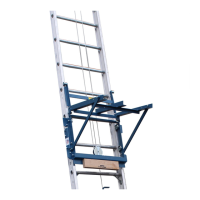Why is my RGC Ladders hoist lifting loads slowly?
- DduarteclarenceAug 3, 2025
Your RGC Ladders hoist may be lifting loads slowly due to several reasons: * The hoist might be attempting to lift more than its stated capacity. Check the capacity rating and reduce the load weight if needed. * There might be too much wire rope on the drum, as hoisting capacity decreases as wire rope diameter increases. * The platform may not be moving freely; check for track obstructions or block and wire rope malfunctions.

